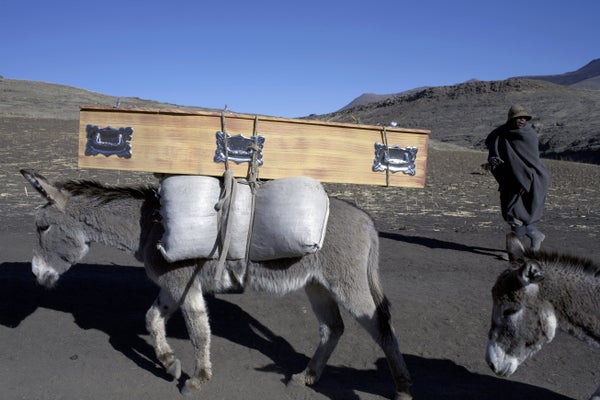This article was published in Scientific American’s former blog network and reflects the views of the author, not necessarily those of Scientific American
The loss of animal life in the ongoing devastation of Australia’s wildfires, now estimated as reaching up to one billion deaths, is rightly garnering extensive news coverage. Charismatic species like koalas and kangaroos are suffering terribly in this massive natural disaster, capturing our attention and empathy. But in other parts of the world there is a human-made disaster of global proportions affecting another species, one we rarely give the attention afforded the iconic koala and kangaroo: the simple donkey.
Donkeys today are subject to a shocking epidemic of illegal capture, inhumane treatment and mass slaughter in many African countries and elsewhere, like Brazil and Pakistan, in order to serve the exploding demands of the traditional Chinese medicine market.
Donkey skins are valued for their gelatin, a key ingredient in ejiao, a traditional Chinese medicine believed to treat illnesses as diverse as anemia, insomnia and reproductive issues.
On supporting science journalism
If you're enjoying this article, consider supporting our award-winning journalism by subscribing. By purchasing a subscription you are helping to ensure the future of impactful stories about the discoveries and ideas shaping our world today.
But China’s own stocks of donkeys have collapsed by 76 percent since 1992, and its annual supply of about 1.8 million donkeys cannot produce enough skins for a surging market which now demands at least four million lives a year. In fact, if the current pace continues, more than half of the world’s donkeys would need to be slaughtered in the next five years to feed China’s demand for ejiao.
Contributing to the problem, the global donkey trade is only loosely regulated. A report in November 2019 by the Donkey Sanctuary linked the trade to criminal networks, animal welfare abuses, increased international biosecurity threats like the spread of anthrax, ecological pollution from unregulated dumping of millions of donkey carcasses, and devastating effects on rural families who have their donkeys stolen.
These effects are especially severe in Africa, where both legal and illegal trade in donkey skins operates in multiple countries. In Botswana, for example, donkey numbers have declined by 39 percent in the last dozen years. Recently, many countries, like Zimbabwe, Niger and Tanzania, have started to fight back by banning the slaughter of donkeys or the export of hides, but enforcement is lacking and the trade continues. In addition, widespread illegal poaching persists in many places. Donkey hides are just too valuable.
In poorer parts of the world where 500 million people depend on donkeys, a healthy working donkey can be key to a family’s economic survival and critical for the transportation of children to school or for women’s participation in the market economy. Indeed, when a donkey is stolen, it is women who are most likely to take on the donkey’s job of physically hauling water and firewood for the family. Far from the idyllic scene of the manger, these lives, for people and their donkeys, are often full of hardship and uncertain futures.
And the lives of donkeys in the skin trade are miserable and often torturous. Crowded into trucks and driven for days without food and water, many arrive dead at the slaughterhouse or with broken bones and open sores. Since none of this affects the value of the skin, little attention is given to their welfare; egregious killings, like being bludgeoned with hammers, have been documented. The American Veterinary Medical Association and the World Veterinary Association both have recently condemned the trade.
All of this may feel like a distant problem for many Americans, but the United States is the third largest importer of ejiao from mainland China, after Hong Kong and Japan. Given that, Americans should take action. One way to help is to donate to reputable international nonprofits who are fighting back, such as the Donkey Sanctuary and the Brooke foundation. Working with local governments and communities in Africa, these nonprofits are helping local residents envision solutions, like the design of corrals that protect their donkeys from abduction.
They are also partnering with China’s International Cooperation Committee for Animal Welfare to improve knowledge of donkey welfare. And global condemnation of the trade can affect production too. Chinese companies have started to explore alternatives, like cellular production of donkey collagen in labs, which might provide future solutions.
Donkeys may not be as charismatic as koalas and kangaroos. But like those animals suffering in the wildfires, they too are in need of drastic action and a worldwide awareness of their plight. As a key driver of the global trade in ejiao, American consumers have a responsibility to educate ourselves and others about this crisis, and to work to address it.
